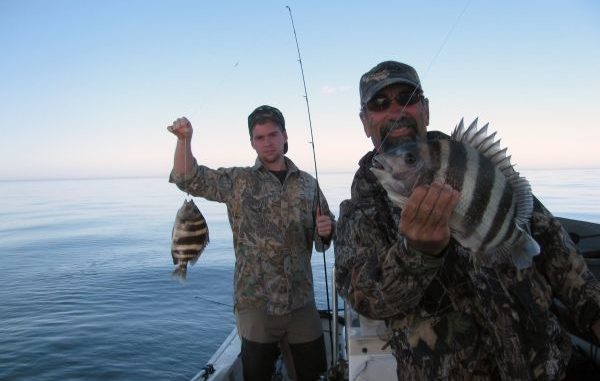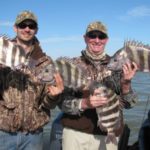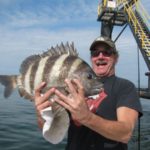
Pick your days this month and load up on sheepshead at shallow rigs just off the coast — no matter where you launch.
“My name is Chadwick, and I’ll be your waiter for this evening,” the poor guy said, with an accent that was obviously not local. “Tonight’s special is grilled bay snapper, topped with crab meat and served with braised brussels sprouts.”
I say “poor-guy” only because we’d arrived at the ritzy restaurant in a party limo. The poor limo driver would know what I mean.
You see, the traditional “pre-Bacchus Ball Ball” at Doc Fontaine’s had been one for the record books — which is really saying something.
They say Bacchus began as a counter to the snobby, stuffy Rex. Well, according to Bacchusite Doc Fontaine, over the years Bacchus itself had acquired many of Rex’s traditionally annoying attributes.
Let’s just say nobody would mistake Doc’s “pre-Bacchus Ball’ festivities for a debutante ball.
Pelayo suddenly clinked his wine glass and motioned the smiling and officious Chadwick over.
“Oh-Oh!” I thought.
Pelayo was looking around the sprawling restaurant table with a smirk we’ve all come to know (and fear.) His wife, Toni, was already frowning and rolling her eyes.
“My good man,” Pelayo said, his eyebrows dancing while addressing Chadwick. “Would you say bay snapper is similar to sheepshead?”
Chadwick’s smile suddenly sagged.
“Sheepshead?” he half-grimaced. “Ummm, ummm — Oh yes! — very similar to sheepshead!”
“Chadwick,” Pelayo followed up, with a quick look around the table, “what is a Sheepshead?”
Artie leaned over and gasped in my ear, hardly able to control himself.
“I saw The Three Amigos Blu-Ray in Pelayo’s truck on the way to last week’s rabbit hunt,” he said. “You know how Pelayo LOVES that bit about El Guapo asking Jefe about the meaning of plethora. So I’m seriously guessing ….”
“Ummm —umm — well, sir,” Chadwick answered Pelayo. “A sheepshead is a very, very fine fish with firm white meat and — why do you ask?”
“Well,” Pelayo continued going into full El Guapo mode. “I just would like to know if you know what a sheepshead is. I would not like to think that a person would tell someone a bay snapper is similar to a sheepshead, and then that person has no idea what a sheepshead is!”
“Forgive me, Mr Pelayo,” a chastened Chadwick answered. “I know that I, Chadwick, do not have your superior intellect and education about the culinary qualities of local fish. But could it be that once again, you are angry at something else, and are looking to take it out on me?”
Actually, I added that last quote for effect.
Thankfully the women intervened and quickly defused the awkward scene. In fact, Pelayo still carries scars on his shins from his wife’s under-the-table intervention.
The waiter (after a trip to the kitchen) actually revealed that “bay snapper” was sheepshead after all — as we all knew from the get-go.
The fact is that the delectable and (finally) respectable-among-local-epicureans sheepshead goes under many other aliases, including sea bream and silver snapper.
This respectability, by the way, actually consists of a proverbial full-circle phenomenon.
To wit: The Times Picayune Creole cookbook (circa 1911) boasted that “(s)heepshead is perhaps the Gulf fish most to be commended for frequent household use, being susceptible of a far greater variety of modes of preparation than any other fish. It is good in any form: broiled, baked, fried or boiled.”
From our table of 12 amazingly obnoxious people, two actually ordered the bay snapper: Doc’s sister-in-law Valerie and her husband Sid.
They’d grown quite fond of sheepshead during their frequent visits to New Orleans from their home in Long Island.
“The plan is for y’all to head back north with plenty of fresh bay snapper fillets again,” Pelayo reminded them, as Chadwick popped the cork, poured the wine and handed Pelayo a glass for his verdict. “We plan to take y’all out on Wednesday to fill a couple boxes with sheepshead.”
“But Doc just cancelled his fishing trip for Wednesday,” Valerie frowned. “He said there’s no tide. And that’s bad for fishing down here, right?”
“That’s bad for Doc’s kind of fishing.” Pelayo corrected. “He’s after specks. You always want moving waaaw-dah for specks, which means you always want a good tidal range — a foot or above; the more the bettah. But what kills Doc’s speck fishing, improves our bay snapper fishing.”
We high-fived across the table, while at that explanation.
“You see, we want a slack tide — a range of a foot to a few inches,” Pelayo continued. “That means less current at the offshore structures. That means we can get our shrimp-tipped jigs closer to the structure, where the sheepshead hang.
“A tidal range of a foot or above usually means the kind of current that keeps your bait away from the barnacle-encrusted pilings around which the structure-hugging sheepshead are concentrating. To come home with a guaranteed couple boxes of delectable fish from the shallow rigs, we always like a slack tide.”
The forecast also called for relatively light east winds — perfect for fishing this area.
But to make absolutely sure, we always check the buoy wind reports on the weather page of LouisianaSportsman.com the morning of the trip. And, perfect for us, there’s a wind velocity report from the very area we fish: Station KDLP – West Delta 27A (AngloSuisse Offshore Partners.)
Actually, we fish the well jackets a few miles closer to shore from this buoy, the WD 24 area mostly. So even if this buoy is reporting — say—12-knot winds from the east or southeast, we still consider the trip a go.
The contour of the shoreline in this area means the shallower Sandy Point rigs remain fairly well protected with any wind ranging from the east, which is common this time of year.
Ideally, you also want a Mississippi river stage of 8 feet or below to fish this area (questionable this month). The river water pouring out of Red, Tiger, Grand and Southwest passes tends to loop westward with the currents and taint the Sandy Point Rig area.
But a higher river stage is no trip-killer: It usually just means you might have to venture out a bit deeper, say, from the 15- to 18-foot depths of WD 24 to the 30 foot depths in the WD 29 area.
Plenty of options out there — which is another attraction.
That they’re the closest offshore platforms (figuring both car and boat ride) available to New Orleans area anglers is the primary attraction for us, because similar fishing (catching, actually) is available at most shallow structures off our coast this time of year.
The sheepshead are spawning, you see. So they’re ravenous, and stacked up around shallow rigs and wellheads from Breton Sound around to East Bay, West Bay, Sandy Point, Grand Isle blocks, Bay Marchand blocks (Fourchon Rigs) to Ship Shoal and out of Bay Calcasieu.
These rigs have another appeal: Most are in state waters. They’re inside that magic 3-mile boundary (and definitely inside the 9-mile zone that is now, by law, at least temporarily designated as state waters).
Check out WD 24 on a map, and you’ll see. But if you want to be ABSOLUTELY sure, simply look at the little identification on the rig or well-jacket itself when you rumble up. When it reads “SL,” that means “state lease.” That means you’re home free with the reds.
We use much the same tackle at Sandy Point we’d use inside — medium spinning gear.
But we tie the jigheads — weighing anywhere from ¼ to ½ ounce, depending on currents — to the tip of a 20-pound mono leader, about 3 feet long.
These fish are serious battlers, so you don’t want them breaking off every third cast when they rub a barnacle.
After hitting the water, we roared out of the Empire jetties and hung a left into gently swelling seas. About 15 minutes later I heard the “clang” of the rig hook as Pelayo did the honors — then a “clink.”
I turned to see Valerie laughing, covering her mouth as her shrimp-tipped jighead (¼-ounce) bounced off the well jacket’s pipe and into the greenish waters. Then she flipped the bail, smiling maliciously with anticipation.
We prefer fishing the little well jackets rather than the bigger platforms themselves. These smaller structures seem to better concentrate the fish around their much smaller structure.
“Get ready!” I counseled, as Valerie reeled a few cranks to get her bait to the preferred 8- to 10-foot depths.
Pelayo and I baited up our plain, 3/8-ounce jigheads with shrimp and dropped down, much like sac-a-lait fishermen over submerged Christmas trees.
I was just flipping the bail when ….
“AHH-AHH!” Valerie was yelling from the stern, her face in half-laugh, half-grimace mode as she cranked away.
Then Sid grunted beside me and his rod dipped till the tip was in the water.
I was looking behind me at the tumult and into the second reel crank when — tap-tap-WHAM I set my own hook.
The fishing was non-stop, and the box quickly filled in only two stops.
Barely two hours later, Pelayo opened the box and motioned us over.
“Amigos, would you say, that we have a plethora of Sheepshead?” he smirked.





